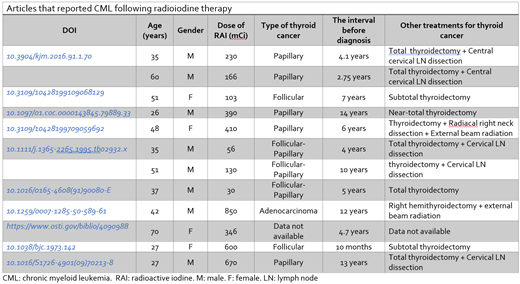Abstract
Introduction
Therapy-related leukemia or secondary leukemia are the terms that describe the occurrence of leukemias following exposure to hematotoxins and radiation to emphasize the difference from leukemia that arises de novo . Many leukemogenic agents have been described, including radiation, alkylating agents, among others . Certain host factors contribute to this predisposition, such as polymorphisms in drug-metabolizing enzymes and inherited cancer predisposition syndrome . These rising leukemias have no specific biologic features that set them apart from de novo malignancies .
Therapy-related acute myeloid leukemia (t-AML) has extensive literature to support it. In contrast, therapy-related chronic myeloid leukemia (t-CML) possibly because it originates from a more potent premature progenitor cell .
Radioactive iodine (RAI) with I 131 has an established role in managing differentiated thyroid carcinoma, namely papillary thyroid carcinoma (PTC) and follicular thyroid carcinoma. However, concerns have been raised about its possible carcinogenic effects. Papers of t-CML following I 131 are increasingly reported, and thus this review is dedicated to highlighting it.
Designs and methods
All reports from the 1960s to date related to CML following RAI therapy were searched on Google Scholar and PubMed. Different search terms with Boolean function to search for the relevant articles. All articles were in English.
Results
We identified ten articles reporting 12 cases, as presented in table 1. We found that most of the reports were for men (8/12) under the age of 60 years (10/12), and the primary tumor was of PTC characteristics (5/12 were PTC, and 3/12 were mixed papillary-follicular carcinoma). The dose of I 131 ranged between 30 millicuries (mCi) to 850 mCi; the mean dose was 331 mCi. Also, t-CML developed within the first ten years (9/12), mainly between 4-7 years post-exposure.
Discussion
A few reports found a statistically significant increased risk of leukemia following RAI therapy; some suggested a relative risk of 2.5 for I 131 vs. no I 131 . Observed findings from these studies include a linear relationship between the cumulative dose of I 131 and the risk of leukemia, doses higher than 100 mCi were associated with a greater risk of developing secondary leukemia, and most of the leukemias developed within the initial ten years of exposure .
The precise mechanism through which RAI provokes leukemia is largely unclear. Possibly, by inducing oxidative stress, reactive oxygen species production results in damage to the cellular membrane, DNA strand breakage, DNA base alterations, and eventually cancer in the instances of poor repair of damage .
Many questions remain open. For example, most of the subjects had PTC histopathology in our review. Is there a relationship between PTC and the emergence of leukemia? This question is relevant because some reported that PTC has a mutation of the RET protooncogene, which has been linked to leukemia, prostate and breast cancers.
Conclusion
Although the risk of t-CML appears to be low based on current reports, it should not be disregarded. Further studies are needed to establish or refute a causal relationship.
No relevant conflicts of interest to declare.


